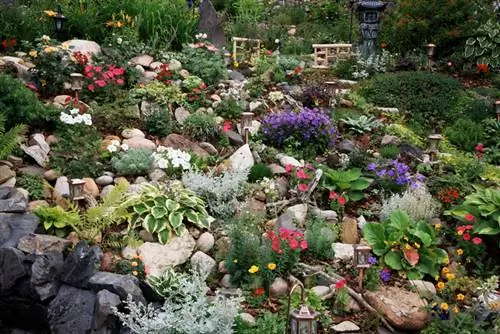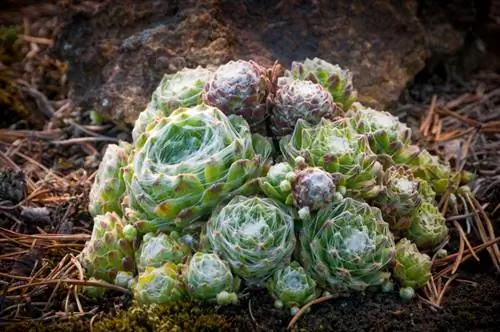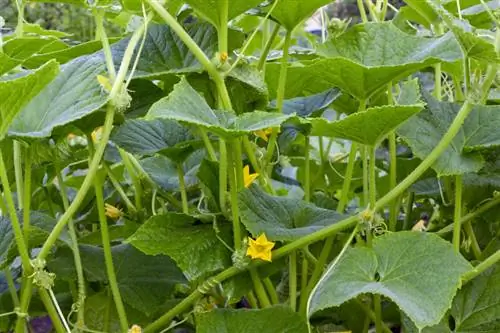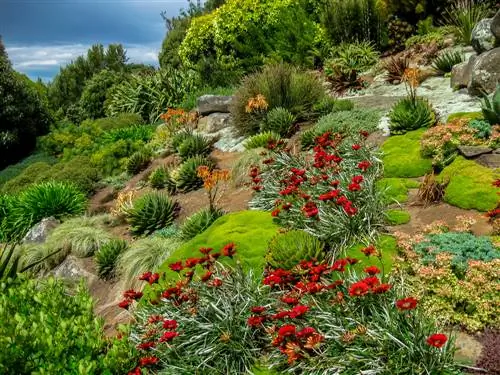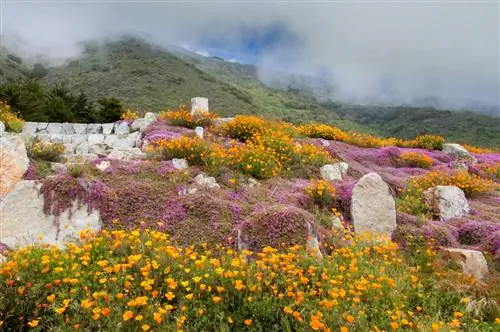- Author admin [email protected].
- Public 2023-12-16 16:46.
- Last modified 2025-01-23 11:21.
Of course, a rock garden can also be designed on a flat surface. However, planting on a slope or embankment is much more interesting - and also more natural. If you don't have one in your garden, you can artificially fill it up and create a rock garden in a variety of ways. Large embankments (which, for example, replace the fence or hedge and can be used wonderfully to hide excavated earth, for example from building a house) can be particularly beautifully planted with large cushion plants such as goose cress, cushion phlox and rockweed.

How do I design a rock garden on a slope?
A rock garden on a slope offers ideal conditions for mountain plants and enables the integration of streams and waterfalls. When planting, pay attention to the different needs of the plants: protect moisture-sensitive plants from rain, heat-sensitive plants from strong sun and pay attention to the moisture for drought-loving plants.
Slope location is ideal for rock gardens
Many rock garden plants come from the mountains. Naturally it is not flat and level there, but rather sloping and rocky. Ergo, you create ideal living conditions for your mountain plants if you recreate the natural conditions. However, not every slope is suitable for creating a rock garden, as most types require a sunny, south-facing location. Some plants also feel comfortable in a partially shaded location, but these should be selected accordingly.
Optimal: The combination of stone and water
A hillside location is ideal for integrating a small stream into the rock garden. This can even be equipped with mini waterfalls and ultimately flow into a pond. For a stream you need pumps (€104.00 on Amazon) that are operated either with a mains connection (then a power connection must be installed) or via a solar module. However, the latter are not suitable if a powerful waterfall is to be installed. A special pond liner is suitable for sealing water surfaces and is covered with a layer of fleece to protect it from damage caused by the stones.
Setting the stones correctly
Special care must be taken when placing and planting stones on a slope. Firstly, such a structure creates different microclimate zones, which the skilled gardener knows how to use to his advantage. In this way, plants with different needs can be planted in the same rock garden.
Planting place for moisture-sensitive plants
Some plants, for example, are very sensitive to moisture and should be protected from rain. To do this, you can let a stone protrude a few centimeters forward over a vertical gap. The resulting roof protects the plant from direct rain.
Planting place for heat-sensitive plants
On the other hand, a stone protruding to the south to the side protects heat-sensitive plants such as spring saxifrage from a strong midday sun.
Planting place for cushion plants
Silverwort, globe flower and other carpet-forming cushion plants thrive particularly well on flat stones or a suitably designed, level slope, over which they can spread unhindered.
Caution: moisture
The amount of water available on a slope also varies greatly depending on the placement of the stones. When planting, remember that steeply inclined stones direct more water to the roots than flat stones - and therefore drought-loving plants should not necessarily be planted directly under one. The humidity can also vary greatly even within a rock crevice: while it is dry at the top, it becomes increasingly moist towards the bottom.
Tip
It's best to start planting while you're piling up the stone chunks: inserting the sensitive root balls later is very time-consuming. This is especially true for trees.

